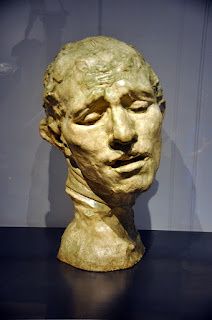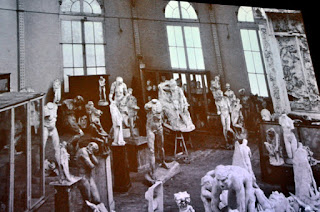On our second day exploring Montreal we set out with great plans to visit several places. Wow were we surprised as we spent almost our entire day at the Montreal Museum of Fine Arts. There is so much there, and more than is possible to view in one day. For sure our greatest excitement of the day was the tour we took of the Rodin Exhibit.
Rodin tried to get into the prestigious Art school - Ecole des Beaux-Arts, and was rejected not once, but three times. Desperate to earn a living, he began working as a decorative bricklayer. After working for nearly 20 years as a bricklayer, around 1870, Rodin made a bold decision to try his hand at art once again. He began working with the sculptor Carrier-Belleuse who became disappointed and dismissed him after a few years. It was only after escaping the art academicism that was being forced upon him, that he finally became free to develop his own style, which was greatly inspired by the works of Michelangelo and also Donatello The Vanquished, his first original work, was so good that he was accused by the art community of having casted the sculpture and not having formed it with his hands. Because of this, many of his later works began to grow in size, in order to prove that he had actually formed the statue with his hands.
One of the unique things about Rodin that we were not aware of is he did all his molding in clay and only molded from human models who would sit for hours over a period of many months. He was so exacting in his forming of the clay. There was one model that frustrated him greatly as day by day he would return to his model and could not seem to understand why things did not line up. As the days went on, it began to become clear as he discovered that his model was pregnant.
But work in clay from live models is basically the total of what Rodin did, and many criticized him for this, often to the point of saying he was not a true artist. He molded the clay after long exacting hours of working with his models. A plaster cast was then made of his works and he would commission others to take his plaster casts and turn them into bronze or marble statues, never doing the marble or bronze work himself. Of further amazement, he kept an incredible collection of plaster hands, feet, legs, you name it and many of his works were developed from picking and choosing from his huge collection of previous pieces that were in his studio, to create a brand new piece. Many of his sculptures he is known for balancing by often using the same hands, such as two right hands in one sculpture. Very different for the time. Often, he would create a sculpture of a partial body, and in his time frame was criticized often for this as well, with some saying his pieces were unfinished. But Rodin, felt they were finished and he eventually became a trailblazer for such art in the future. The details of his work were so fascinating to see as was learning about his unclassical approach of reusing and combining the pieces from some of his other creations.
After the tour, we visited a good portion of the remaining museum, but there is just so much we could not see it all. We were there until almost 5 PM. We have tried to provide a few pictures off many of the works of art that we saw. Of further note, the museum lighting is some of the best we have seen and you could really see the way that many of the artists brought out the light in their works. Fascinating, just a simply fascinating day.
We headed back to the metro, detouring to another Metro station in hopes of getting to see the Cathedral of Marie -Reine-du-Monde before they closed the doors. We arrived just prior to a baby baptism and we were able to take a quick look and snap a few quick pictures.
The church name translates in English to Mary, the Queen of the World Cathedral. This is the third largest church in the province of Quebec and is the seat of the Catholic Archdioceses of Montreal. The church was completed in 1894. The statues at the front of the Cathedral,, on the outside are not the 12 apostles but rather the 13 patron saints of 13 parishes in Montreal, who donated them. It was a quick look and sorry we don't have more information. But we were glad to get a peek as the church is beautiful.
Rodin tried to get into the prestigious Art school - Ecole des Beaux-Arts, and was rejected not once, but three times. Desperate to earn a living, he began working as a decorative bricklayer. After working for nearly 20 years as a bricklayer, around 1870, Rodin made a bold decision to try his hand at art once again. He began working with the sculptor Carrier-Belleuse who became disappointed and dismissed him after a few years. It was only after escaping the art academicism that was being forced upon him, that he finally became free to develop his own style, which was greatly inspired by the works of Michelangelo and also Donatello The Vanquished, his first original work, was so good that he was accused by the art community of having casted the sculpture and not having formed it with his hands. Because of this, many of his later works began to grow in size, in order to prove that he had actually formed the statue with his hands.
One of the unique things about Rodin that we were not aware of is he did all his molding in clay and only molded from human models who would sit for hours over a period of many months. He was so exacting in his forming of the clay. There was one model that frustrated him greatly as day by day he would return to his model and could not seem to understand why things did not line up. As the days went on, it began to become clear as he discovered that his model was pregnant.
But work in clay from live models is basically the total of what Rodin did, and many criticized him for this, often to the point of saying he was not a true artist. He molded the clay after long exacting hours of working with his models. A plaster cast was then made of his works and he would commission others to take his plaster casts and turn them into bronze or marble statues, never doing the marble or bronze work himself. Of further amazement, he kept an incredible collection of plaster hands, feet, legs, you name it and many of his works were developed from picking and choosing from his huge collection of previous pieces that were in his studio, to create a brand new piece. Many of his sculptures he is known for balancing by often using the same hands, such as two right hands in one sculpture. Very different for the time. Often, he would create a sculpture of a partial body, and in his time frame was criticized often for this as well, with some saying his pieces were unfinished. But Rodin, felt they were finished and he eventually became a trailblazer for such art in the future. The details of his work were so fascinating to see as was learning about his unclassical approach of reusing and combining the pieces from some of his other creations.
After the tour, we visited a good portion of the remaining museum, but there is just so much we could not see it all. We were there until almost 5 PM. We have tried to provide a few pictures off many of the works of art that we saw. Of further note, the museum lighting is some of the best we have seen and you could really see the way that many of the artists brought out the light in their works. Fascinating, just a simply fascinating day.
We headed back to the metro, detouring to another Metro station in hopes of getting to see the Cathedral of Marie -Reine-du-Monde before they closed the doors. We arrived just prior to a baby baptism and we were able to take a quick look and snap a few quick pictures.
The church name translates in English to Mary, the Queen of the World Cathedral. This is the third largest church in the province of Quebec and is the seat of the Catholic Archdioceses of Montreal. The church was completed in 1894. The statues at the front of the Cathedral,, on the outside are not the 12 apostles but rather the 13 patron saints of 13 parishes in Montreal, who donated them. It was a quick look and sorry we don't have more information. But we were glad to get a peek as the church is beautiful.































No comments:
Post a Comment